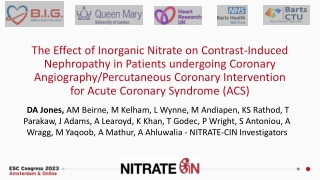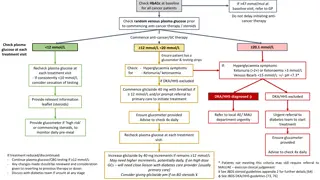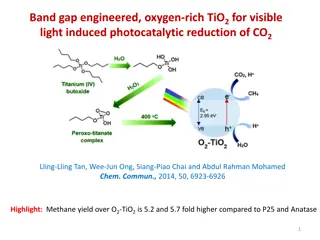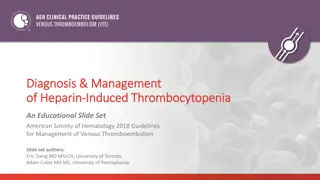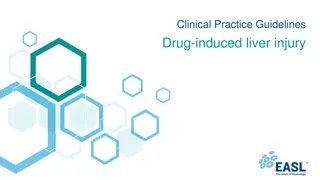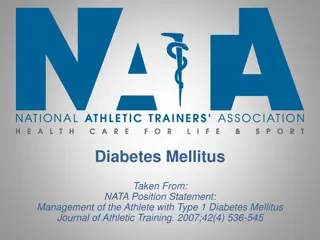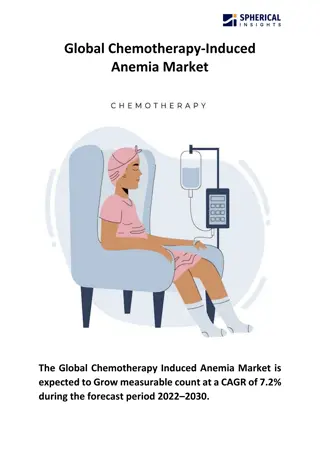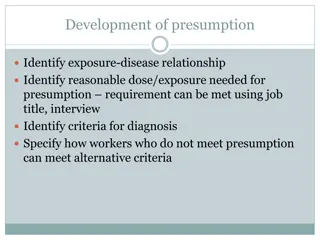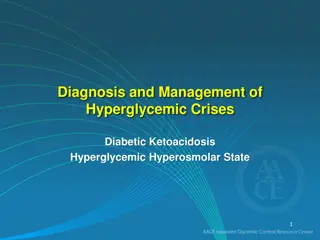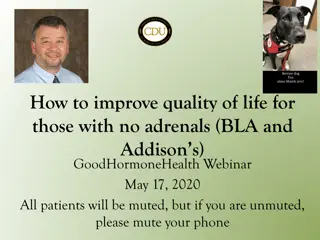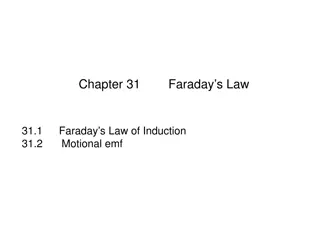Glucocorticoid-Induced Hyperglycemia
Glucocorticoids, like prednisolone, can induce hyperglycemia through various mechanisms, affecting insulin resistance and glucose levels. This phenomenon is influenced by dosing patterns and pharmacokinetics. Managing hyperglycemia while avoiding hypoglycemia is essential in treatment.
Download Presentation

Please find below an Image/Link to download the presentation.
The content on the website is provided AS IS for your information and personal use only. It may not be sold, licensed, or shared on other websites without obtaining consent from the author.If you encounter any issues during the download, it is possible that the publisher has removed the file from their server.
You are allowed to download the files provided on this website for personal or commercial use, subject to the condition that they are used lawfully. All files are the property of their respective owners.
The content on the website is provided AS IS for your information and personal use only. It may not be sold, licensed, or shared on other websites without obtaining consent from the author.
E N D
Presentation Transcript
Glucocorticoid induce hyperglycemia OCTOBER 2020
Glucocorticoids are most commonly prescribed as the semi-synthetic formulation prednisolone (or prednisone in some parts of the world), which is usually administered as a single morning dose . Prednisolone therapy is usually prescribed in two main patterns. It can be prescribed short-term in medium-high doses to treat an acute inflammatory illness such as an exacerbation of obstructive lung disease, often in the hospital setting. Prednisolone is also prescribed long term at lower doses, usually less than 10mg/day, to attenuate chronic inflammatory disease progression
PHARMACOKINETICS AND PHARMAIODYNAMICS: Steroids of adrenal origin are synthesized from cholesterol and their secretion followed a circadian pattern and a pulsatile ultradian rhythm. Normal secretion ranges from 8 to 15 mg / day of which 10% circulates in free form, the rest is bound to carrier proteins mainly albumin and cortisol binding globulin. The plasma half-life ranges from 80-270 min. depending on the type of glucocorticoids used, with an action in tissue that last for 8-12 h. They are metabolized in the liver and their conjugated metabolites are excreted mainly by the kidney.
The development of insulin resistance is mainly post prandial and varies depending on the type of steroid used; intermediate acting glucocorticoids which a peak of action 4-6 h. Following their administration; their effect on glucose level is mainly during the afternoon and might without effect on fasting glucose when they are administered in a single dose. On the other hand, they cause persistent hyperglycemia when administrated in divided doses. Dexamethasone fits in the long acting glucocorticoids with a steroid hyperglycemia that lasts for more than 24h, with a slight decline during an overnight fast.
A single daily dose of glucocorticoid (e.g. prednisolone) in the morning may be the most common mode of administration. In those who are susceptible, this will result in a rise in blood glucose by late morning that continues through to the evening. Overnight, the blood glucose generally falls back, often to baseline levels by the next morning. Thus, treatment should be tailored to treating the hyperglycaemia, while avoiding nocturnal and early morning hypoglycaemia. Glucose levels can be expected to rise ~ 4 8 h after the administration of oral glucocorticoids, and ~ 5 h after the administration of intravenous glucocorticoids.
Mechanisms of glucocorticoid-induced hyperglycaemia: Glucocorticoid-induced hyperglycaemia is the result of impairment of multiple pathways affecting carbohydrate metabolism. Glucocorticoids induce peripheral insulin resistance, which predominantly reflects insulin action in skeletal muscle . At higher doses glucocorticoids impair oxidative and non-oxidative glucose disposal, whereas in patients on long-term low-dose prednisolone non-oxidative glucose disposal is predominantly reduced . Glucocorticoids reduce glycogen synthase activity in skeletal muscle, which will contribute to a reduction in peripheral non-oxidative glucose disposal .
Glucocorticoids cause hepatic insulin resistance resulting in increased hepatic glucose output, even during long-term low-dose prednisolone therapy . Acutely glucocorticoids also reduce insulin secretion, but insulin secretion is not reduced in patients on long-term low-dose prednisolone . An acute reduction in incretin-induced insulin secretion is likely to contribute to the observed reduction in insulin secretion with glucocorticoids .
How common is prednisolone-induced hyperglycaemia? Glucocorticoids are prescribed short term in moderateto-high doses to treat exacerbations of a range of inflammatory illnesses including those of the lungs, gastrointestinal tract, nervous system, joints, kidneys and skin. 50 70% of hospitalized patients without known diabetes prescribed moderate-to-high glucocorticoid doses also develop hyperglycaemia . Differences in patient populations will contribute to variability in the prevalence of hyperglycaemia.
Is treating hyperglycaemia during acute prednisolone therapy important? In hospitalized patients, the primary aim of treatment of hyperglycaemia is to prevent any potential excess in morbidity and mortality secondary to glucose elevation during treatment and recovery from an acute illness or surgical procedure . There is little direct evidence that treating prednisolone-induced hyperglycaemia reduces morbidity or mortality. Current guidelines recommend screening all hospitalized patients prescribe glucocorticoids for hyperglycaemia by point of care blood glucose level monitoring for at least 48h and treatment of those with hyperglycaemia. there are plausible mechanisms by which short-term hyperglycaemia might increase morbidity and mortality, such as inducing endothelial dysfunction and oxidative stress .
Glucose targets: In line with other Joint British Diabetes Societies (JBDS) for Inpatient Care documents, the recommended glucose target level for those in hospital is 6 10 mmol/l, accepting a range of 4 12 mmol/l. However, certain groups do not require such tight control (e.g. those at the end of life) and others who may be severely disabled by a hypoglycaemic event, for example, people with dementia, the confused, the frail older person, people at risk of falling or those with variable appetite and /or dietary intake.
What therapy should be used to treat acute prednisolone-induced hyperglycaemia? Once-daily steroid treatments: Morning administration of basal human insulin may closely fit the glucose excursion induced by single dose of oral steroid in the morning. Following an oral morning dose of prednisolone the glucose concentration peaks 8h later at about 16:00h . In patients without known diabetes glucose returns to normal by midnight with little effect on overnight glucose concentration . In patients with diabetes, glucose elevations are greater, but the circadian pattern of hyperglycaemia is similar .
These studies support recommendations to use insulin isophane alone or in combination with short-acting insulin to treat glucocorticoid-induced hyperglycaemia. When administered as a single morning dose, insulin isophane s onset of action, peak effect and duration of action closely match the pattern of prednisolone induced hyperglycaemia. Thus, insulin isophane has the potential to better treat daytime hyperglycaemia and avoid overnight hypoglycaemia arising from longeracting basal insulin preparations.
Multiple doses of steroid treatments: Multiple doses of oral or intravenous steroid will likely result in hyperglycaemia throughout the day and night. In these circumstances it is likely that subcutaneous insulin using a multiple daily injection regimen, will be the most appropriate choice to achieve glycaemic control in the event of hyperglycaemia for the majority of people. dividing prednisolone into two daily doses attenuates the daytime peak in glucose and reduced mean daily glucose, but patients have a higher glucose concentration overnight.
Consequently patients on twice-daily prednisolone with hyperglycaemia are probably best treated with a longer-acting basal insulin with a flatter insulin profile, such as glargine or detemir, alone or in combination with a short-acting insulin if there are postprandial glucose elevations. Dexamethasone has a longer serum half-life and duration of action than prednisolone, but whether it causes a glucose peak is not clearly documented. dexamethasone induced hyperglycaemia should also be treated with a longer-acting basal insulin.
What insulin dose should be prescribed for prednisolone-induced hyperglycaemia in hospital? In our study insulin-na ve patients were prescribed a starting daily insulin dose of 0.5units/kg plus supplemental insulin for hyperglycaemia, resulting in a daily insulin dose of more than 0.6units/kg We recommend that in hospitalized patients, where the aim is rapid glycaemic control, most patients who have not previously been on insulin should be prescribed an initial daily dose of 0.5units/kg. Patients at increased risk of hypoglycaemia should be started on a lower daily insulin dose, such as 0.3 0.4units/kg.
Insulin dosing requirements in patients with type 2 diabetes who are already taking insulin are even less studied. In our study, we increased daily insulin dose by 30% or to 0.5units/kg, whichever was greater . However, during continuous glucose monitoring, the blood glucose level was above 10mmol/L for 70% of the day. Therefore, most patients with similar clinical characteristics to those in our study will require >30% increase in insulin to achieve good glycaemic control.
Type 1 diabetes: For those using a twice-daily pre-mixed insulin regimen, a 10% increase in the morning insulin dose should be considered every 24 48 h. An increase in lunch and evening meal short-acting bolus insulin dose may be warranted if a basal bolus regimen is utilized . hospital discharge planning: it is critical that hospitalized patients with prednisolone induced hyperglycaemia are given advice regarding reducing insulin doses as prednisolone is tapered or stopped to prevent hypoglycaemia.
Patient whose insulin requirments decrease to <20 units per day can be transitioned to oral hypoglycemic agents. The person on insulin therapy should be trained in self-monitoring of CBG and test once daily in the late afternoon or evening. Given the recent hyperglycaemia, the use of HbA1c as a screening tool to diagnose diabetes should be delayed for 3 months following steroid cessation. A fasting glucose, or oral glucose tolerance test (OGTT), may be advantageous if a diagnosis of diabetes is clinically suspected prior to 3 months elapsing.
Outpatients with high-dose prednisolon induced hyperglycaemia: if insulin is prescribed, practically once-daily treatment with a morning dose of isophane insulin is easier for patients to learn to administer than multiple daily insulin injections. We recommend starting with a lower daily insulin dose of 0.3 0.4 units/kg as the support to manage severe hypoglycaemia in the community might not be as prompt as in hospital.
Does long-term low-dose prednisolone increase blood glucose? As the effects of glucocorticoids on blood glucose concentration are dose dependent. Most patients with inflammatory rheumatologic disease are prescribed daily prednisolone doses below 10mg . However, while these doses are much lower than those used acutely, they are substantially higher than average endogenous glucocorticoid production, which equates to about 3mg prednisolone per day. These results might be expected as low-dose prednisolone causes insulin resistance in liver and skeletal muscle . On balance, long-term prednisolone therapy at daily doses below 10mg causes mild postprandial hyperglycaemia, but minimal change in fasting glucose or HbA1c.
How should you screen for diabetes in patients on long- term prednisolone? as prednisolone predominantly increases postprandial glucose, fasting glucose has low sensitivity to diagnose diabetes in this patient group . Consequently, the 2-h plasma glucose concentration during an oral glucose tolerance test identifies more cases of diabetes in patients on long-term prednisolone than fasting glucose or HbA1c . Some authors have proposed that a late afternoon random glucose should be used to screen for diabetes in patients taking prednisolone .
Metformin has prospective randomized controlled trial evidence supporting its efficacy and does not exacerbate the potential adverse effects of prednisolone and is a suggested first- line therapy in outpatients taking long-term low-dose prednisolone.
Since glucocorticoids affect pancreatic cells and suppress insulin secretion , insulin secretagogue may be reasonable for treating GIH . Sulfonylureas promote insulin release from pancreatic cells.Kasayama et al reported glimepiride improved mean fasting PG levels in 3 patients with GIH. But,sulfonylureas carry a risk of hypoglycemia overnight because of the longer duration of action . Glinides are fast- and short-acting stimulator for insulin secretion, targeting postprandial hyperglycemia. Meglitinides require multiple daily doses but have the potential advantages of predominantly affecting postprandial glucose and no weight gain .
In a small open study, repaglinide provided effective glycaemic control in 14 of 23 patients on low-dose prednisolone combined with other immunosuppressive therapy Although these retrospective studies suggested the efficacy of glinides for GIH, there have been no designed prospective studies to confirm that. DPP-4 inhibitors theoretically can be effective to treat GIH because glucocorticoids particularly affect postprandial glucose metabolism.
Actually, some case series suggested the efficacy of DPP-4 inhibitors for GIH. The efficacy of DPP-4 inhibitors for GIH has been unclear. In terms of safety, DPP-4 inhibitors may affect immune system because DPP-4 is expressed on lymphocytes and synovial fibroblasts. Some case reports suggested that DPP-4 inhibitors might be involved in new onset or exacerbation of arthritis.
longer-term data on the efficacy of GLP-1 agonists in patients taking prednisolone is lacking. Liraglutide has not been studied in patients on prednisolone but its non-glycaemic effects are favourable as it can cause weight loss and reduce fracture and cardiovascular risk . In contrast, some data suggest exenatide may increase fracture risk. GLP-1 receptor agonists generally have stronger effect on reduction of PG levels than DPP-4 inhibitors . GLP-1 receptor agonists may be a potential therapeutic agent for GIH, although there have been no prospective studies to evaluate the effect of GLP-1 receptor agonists in patients with GIH.
Dulaglutide improves glucocorticoidinduced hyperglycemia in inpatient care and reduces dose and injection frequency of insulin(may 2020) Dulaglutide (Dula) is a long-acting glucagon-like peptide-1 receptor agonist (GLP-1RA) administered once weekly. A dose of 0.75 mg per week has been approved since 2015 for the treatment of T2DM in Japan. this study aimed to retrospectively assess whether Dula could safely improve GC-induced hyperglycemia and lower insulin injection frequency and dose. The result suggests that, in GC induced hyperglycemia, Dula may contribute to increase patients QOL by reducing injection frequency.
A small RCT evaluated the efficacy of pioglitazone for GIH in 40 patients with rheumatic diseases . Compared with controls, pioglitazone improved the PG levels 2 hours after oral glucose tolerance test (288 13 mg/dL vs 203 9 mg/dL), HbA1c (7.9 0.3 % vs 6.6 0.1 %) and homeostasis model assessment-insulin resistance (3.4 0.3 vs 2.0 0.3) after 6 months. The RCT included patients with relatively mild GIH during maintenance therapy with low-does prednisolone. It is unclear whether pioglitazone can be effective for managing GIH during remission induction therapy using high-dose glucocorticoids.
Although there have been no clinical studies to assess SGLT2 inhibitors in patients with GIH, the pharmacological mechanism suggests some potential merits and demerits for treating GIH. First of all, the biggest advantage of SGLT2 inhibitors is reducing the cardiovascular events in patients with type 2 diabetes among the oral hypoglycemic agents. SGLT2 inhibitors possess the bonus effect on reducing weight and blood pressure , thus considered reasonable for managing total cardiovascular risks in patients with GIH. If SGLT2 inhibitors are used in patients with GIH, the risk of severe infections may increase due to immunosuppression by glucocorticoids. SGLT2 inhibitors may promote the risk of glucocorticoid-induced osteoporosis and myopathy.
Steroid treatment in pregnancy: As in other situations, steroid administration in pregnancy may cause transient hyperglycaemia, or result in increased levels of hyperglycaemia in those with gestational diabetes mellitus (GDM) or pre-existent diabetes. The majority of steroid use in pregnancy will be two single doses administered intramuscularly to promote foetal lung maturity at birth. This will require CBG monitoring at regular intervals we suggest four times daily. The duration of this testing will depend on whether the steroid doses are single or multiple. If the CBG is > 12 mmol/l on consecutive readings treating the hyperglycaemia should be considered. If the person is already on insulin, the doses may need to be increased significantly by 40% or more at the time of the first steroid injection, for a period of 24-48h.


